
Murshidabad is a historical city in the Indian state of West Bengal. It is located on the eastern bank of the Bhagirathi River, a distributary of the Ganges. It forms part of the Murshidabad district.
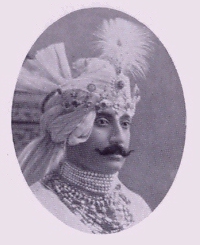
Sir Sayyid Wasif Ali Mirza Khan Bahadur was the Nawab of Murshidabad during 1906–1959. Sir Wasif Ali Mirza was educated at Sherborne School, Rugby School and later at Trinity College. He succeeded his father Hassan Ali Mirza Khan Bahadur at his death on 25 December 1906. On 11 December 1931, Wasif Ali was forced to surrender the administration of his estates to the Government of India after incurring a debt of ₹19 lakhs. On 15 August 1947, the Radcliffe Award allotted the district of Murshidabad to Pakistan and the flag of Pakistan was hoisted at the Hazarduari Palace but within two days the two dominions exchanged Khulna, which is now in Bangladesh, and then the flag of India was hoisted at the grand palace on 17 August 1947. The Government of India also resumed him all his estates in 1953. Wasif Ali was also the founder and president of the Hindu–Muslim Unity Association in the year 1937, named Anjuman-e-Musalman-e-Bangla, which promoted Hindu–Muslim unity. The Nawab also built the Wasif Manzil.
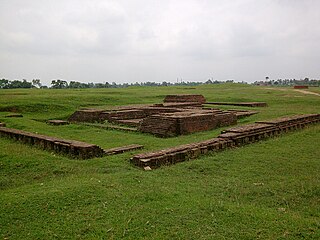
Karnasuvarna or Karnasubarna was an ancient city, located in the present day Berhampore CD block in the Berhampore subdivision of Murshidabad district, West Bengal, India. It was the capital of Gauda Kingdom.

Murshidabad-Jiaganj is a community development block that forms an administrative division in the Lalbag subdivision of Murshidabad district in the Indian state of West Bengal.

The Katra Masjid is a former caravanserai, mosque and the tomb of Nawab Murshid Quli Khan. It was built between 1723 and 1724. It is one of the largest caravanserais in the Indian subcontinent. It was built during the 18th century, when the early modern Bengal Subah was a major hub of trade in Eurasia. The Katra Masjid is located in the north eastern side of the city of Murshidabad, in the Indian state of West Bengal. The most striking feature of the structure are the two large corner towers having loopholes for musketry.

Kathgola Palace is a historical building belonging to the Dugar family at Kathgola in the Murshidabad-Jiaganj CD block of Murshidabad district. It now houses a museum.

Hazarduari Palace, earlier known as the Bara Kothi, is located in the campus of Kila Nizamat in Murshidabad, in the Indian state of West Bengal. It is situated near the bank of river Ganges. It was built in the nineteenth century by architect Duncan Macleod, under the reign of Nawab Nazim Humayun Jah of Bengal, Bihar and Orissa (1824–1838).
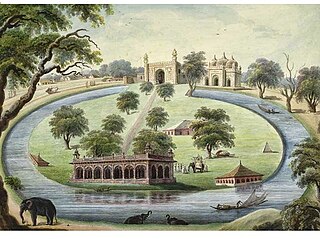
Motijhil, also known as Company's Lake due to its association with the East India Company, is a horse-shoe shaped lake in Murshidabad, West Bengal, India. It was created by Nawazish Muhammad Khan, the son-in-law of Nawab Alivardi Khan. He also constructed a precious palatial palace beside this lake which is called the Sang-i-Dalan which is also known as the Motijhil Palace. It is located at the bend of this lake. It was used as the residence of Nawazish and Ghaseti Begum, Nawazish's beloved wife. It is said that after Nawazish died, Ghaseti Begum lived here until Nawab Siraj ud-Daulah took over the palace and seized the residents' in 1756 AD. With this money he built a similar lake with a beautiful palace, Hirajheel, on the opposite side of the Hooghly River. The palace has a lofty gateway, a mosque known as the "Shahamat Jang" and the Kala Masjid and some other buildings which were all built by Nawazish. This palace was built in 1740. As far as etymology is concerned, the palace has been named so as it was built using black basalt pillars which were brought from the ruins of Gaur. Thus, it was given the name of Sang-i-Dalan or the Stone Palace. This palace was then decorated with different varieties of flower plants and precious marbles.

Fauti Mosque is a mosque at Kumarpur in the Murshidabad-Jiaganj CD block in the Lalbag subdivision of Murshidabad district in West Bengal, India. It was built by Nawab Sarfaraz Khan in 1740 AD. The old Fauti Masjid is one of the largest mosques in the town of Kumarpur and Murshidabad district.

The Nizamat Imambara is a Shia Muslim congregation hall (imambara) in Murshidabad, India. It was built in 1740 AD by Nawab Siraj ud-Daulah and rebuilt in 1847 by Nawab Mansur Ali Khan after it was destroyed by the fires of 1842 and 1846. It is frequently mentioned as the largest imambara in the world.

Wasif Manzil was built by Nawab Wasif Ali Mirza Khan under the direction and supervision of Mr. Vivian, officer of the Public Works Department of the Nadia Rivers Division and Surendra Barat, a Bengali engineer. This building, rather palace was used by the Nawab as his residence. The building is extremely close to the Hazarduari Palace. It is built on the Nizamat Fort Campus between the campus's Dakshin Darwaza and the Hazarduari Palace, just opposite the campus's South Zurud Mosque and parallel to the Bhāgirathi-Hooghly River.

The Madina Mosque is a mosque in the Nizamat Fort Campus in Murshidabad, West Bengal, India. There are two Madina mosques in the fort campus, the old one built by Nawab Siraj ud-Daulah during the 18th century.and the new one by Nawab Mansur Ali Khan in 1847.
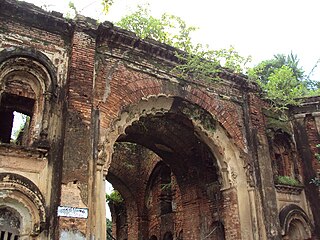
Namak Haram Deorhi was the palace of Mir Jafar. It is located just opposite to the Jafarganj Cemetery in the Lalbagh area of the town of Murshidabad and near Mahimapur in the Indian state of West Bengal. Namak Haram Deorhi refers to both the place of Mir Jafar and the main gate which leads to the palace. This building was used as the residence of Mir Jafar, before he ascended the musnad of Bengal or when he was the Commander-in-Chief of the subha.
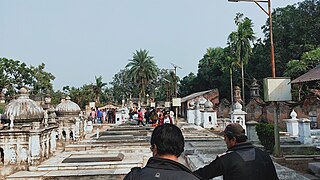
Jafarganj Cemetery is located in Murshidabad, West Bengal, India.
Tomb of Mir Madan is located at Faridpur, in the Beldanga II CD block in the Berhampore subdivision of Murshidabad district.
Rosnaiganj is a village in the Murshidabad-Jiaganj CD block in the Lalbag subdivision of Murshidabad district in the state of West Bengal, India.
Tomb of Azimunissa Begum is located at Azimnagar, in the Murshidabad district.

Kherur Mosque is located at Kherur in the Sagardighi CD block in the Jangipur subdivision of Murshidabad district, West Bengal, India.

Dutch Cemetery is a heritage Christian cemetery at Kalikapur in the Berhampore CD block in the Berhampore subdivision of Murshidabad district, West Bengal, India.

Jama Masjid is a congregational mosque located at Motijhil, in the historic city of Murshidabad, West Bengal, India.






















